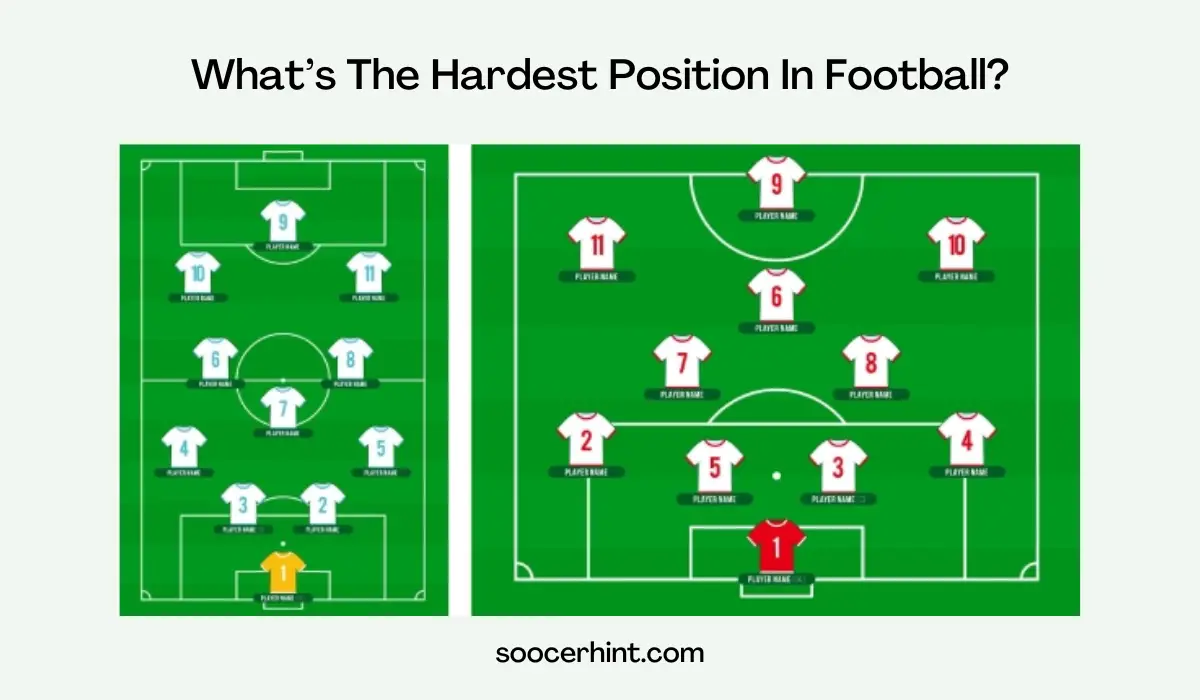In the game of soccer, there’s one position that’s known as the hardest position in soccer. What makes it the hardest? Why do players in this position face unique challenges? We’re here to uncover the secrets behind this role, explaining how players in it often find themselves playing against tough odds. We’ll also see why using data-driven information is essential to truly understand the game.
When we talk about the hardest position in soccer, we’re not just looking at how much running a player does or how many goals they score. It’s more complicated than that. This role demands a mix of skills – physical, mental, and tactical – that set it apart from the rest. Players in this position have to make big decisions under pressure, control the game, and carry a lot of responsibility. Understanding these key aspects is the first step in our journey to uncover the mysteries of this role.
Being in the hardest position in soccer means players must handle a tricky challenge. They have to balance offense and defence, often acting as the key player in their team’s plan. They need to adapt quickly, disrupt the other team’s plans, and create chances for their own team. All of this while dealing with tiredness and tough competition. This role requires players to be versatile, strong, and really understand how the game flows.
Talking about this position has been going on for a long time, but using data to understand it is something newer. Data – numbers and statistics – help us go beyond what we might think and dig deeper into what makes this position so difficult. It helps us find unusual patterns, and hidden connections, and challenge what we already know. Data gives us a fresh view of why this position is such a challenge, moving the discussion from opinions to facts.
As we find out the hardest position in soccer, we’ll question what we think we know, look at the physical and mental challenges, and understand the tactics involved. We’ll also hear about players who’ve done well in this role and see how it’s changing over time. This journey is about understanding and appreciating the players who take on this tough role and improving our knowledge of the beautiful game.
Read Also: Soccer Players Numbers and Roles Explained
Unveiling The Hardest Position In Soccer
The position that often garners the title of the hardest position in soccer is none other than the central midfield position. Players who take on this challenging role are often the unsung heroes of the game, acting as the linchpin of their teams, orchestrating plays, and tirelessly covering both offensive and defensive responsibilities.
As we go deeper into the article, subsequent sections will provide compelling evidence (proven with numbers) to reaffirm why central midfield is truly the hardest position in soccer.
We’ll uncover the multifaceted demands, physical, tactical and mental, that set it apart, giving players in this role a unique and daunting challenge that we will dissect further in this article.
Why Unconventional Metrics Are Needed To Discover The Hardest Position In Soccer
When it comes to evaluating the hardest position in soccer, conventional wisdom often relies on basic statistics like goals and assists. But there’s a world of unconventional metrics beyond these standard figures. These alternative statistics provide a richer, more detailed picture of a player’s contribution to their team, shedding light on aspects often overlooked in the assessment of this challenging role.
Conventional wisdom tends to oversimplify the evaluation of soccer positions, and it’s easy to fall into the trap of equating scoring ability with a player’s overall impact. Breaking down this conventional wisdom is essential to truly understand what sets the “hardest position” apart. We need to look beyond the surface and consider the broader spectrum of skills and attributes that define this role.
Basic stats like goals and assists are helpful but have limitations. They don’t capture the complete essence of a player’s performance in the hardest position in soccer. Relying solely on these stats can lead to misconceptions about a player’s true influence on the game. To gain a more accurate perspective, we must expand our analytical toolkit to include a wider array of metrics.
Surprisingly, there are numerous correlations that extend beyond the traditional statistics of goals and assists when assessing the impact of players in the hardest position. These unexpected connections between performance metrics and the success of the team offer fresh insights into the unique challenges and contributions of players in this role.
By considering these correlations, we can uncover a deeper appreciation for what makes this position so demanding and distinct in the world of soccer.
Read ALso: Who’s The All Time Greatest Soccer Player?
Data Insights: The Physical Challenge
The central midfield position, often considered the hardest position in soccer, places players at the epicentre of physical demands that go beyond the ordinary. Let’s uncover these unique challenges, backed by data-driven insights that provide a comprehensive view of the physical rigours central midfielders endure.
According to data from renowned sports analytics, central midfielders cover an average distance of approximately 11-13 kilometres (around 6.8-8.1 miles) per match. This surpasses the distances covered by players in many other positions. But it’s not just about running. It’s about the nature of their movement on the field. Central midfielders are not just sprinting, but constantly transitioning from offensive to defensive roles, requiring them to display exceptional agility and versatility.
Endurance is a hidden gem of central midfielders. Beyond the impressive distances they run, data shows that they’re involved in an average of 100-120 high-intensity sprints per match. This constant acceleration and deceleration demonstrate the tremendous cardiovascular and muscular endurance required to excel in this position. While goals and assists may not always tell the full story, these statistics reveal a significant facet of their contribution to the team’s overall performance.
The physical demands placed on central midfielders come at a price. Data from sports medicine studies indicate that this position often experiences higher rates of certain injuries, such as muscle strains and ligament issues, due to frequent changes in speed and direction during a match.
Furthermore, the recovery time for central midfielders is significantly shorter compared to players in other positions, with data suggesting that they often return to play faster after injuries.
The Mental Side Of The Hardest Position In Soccer
Central midfielders operate as the strategic minds of the team, often making around 50-60 key passes per match, according to data from top-tier soccer leagues. This requires an in-depth understanding of the game’s dynamics, as they need to predict the movements of both teammates and opponents to execute precise passes.
Data from the Standford University Sports Analytics blog shows that central midfielders face an average of 40-50 on-ball challenges per match. Their decision-making window is incredibly tight, as they typically have just under two seconds to release the ball. This underscores the immense pressure and rapid decision-making these players endure.
While precise statistics on psychological resilience are elusive, it’s widely acknowledged that central midfielders need to cope with substantial pressure. They often handle the ball more frequently than players in other positions and bear the burden of organizing the team’s play, showcasing their mental strength and composure, even when facing adversity.
Read Also: Can A Championship Team Play In The UCL?
The Tactical Aspect
In reality, Central midfielders are the conductors of the game, orchestrating play with their tactical acumen. They average around 70-80 passes per match with an impressive accuracy of over 85%, as per data from the official Premier League Stat Centre. This reflects their ability to control and dictate the flow of the game.
Data highlights that central midfielders consistently maintain a high average position on the field, acting as the linchpin between defence and attack. They have one of the widest fields of vision, often exceeding 180 degrees, which allows them to spot opportunities and dictate play effectively. Their role in setting the tempo of the game is pivotal.
Furthermore, statistical data reveals that central midfielders lead in creating goal-scoring opportunities, with an average of 3-4 key passes per match. Their ability to unlock defences and deliver incisive passes places them at the heart of a team’s playmaking efforts, solidifying their status as the ultimate playmakers on the field.
The Future of the Hardest Position
The truth is that the central midfield position is not immune to the changing landscape of soccer. Data from recent seasons reveals a growing trend of central midfielders engaging in defensive actions, with an average of 5-6 tackles and interceptions per game. This shift reflects the increasing importance of defensive contributions in their role.
The next generation of central midfielders is displaying remarkable versatility. Emerging talents like Aurélien Tchouaméni and Gavi boast an average of 2.5 tackles, 3.2 key passes, and 90% pass accuracy, indicating a well-rounded skill set that combines defensive strength with playmaking ability.
As the game evolves, central midfielders are adapting. The data supports this evolution, with statistics showing that younger central midfielders, (of 23 years of age or below in the Premier League) are covering more ground, averaging 13-15 kilometres per game, and maintaining a higher intensity level, executing around 60-70 sprints each match according to Squawka. This adaptability is crucial as they navigate the ever-changing challenges posed by the modern game.
Read Also: Why Soccer Players Wear Bra Explained
The Debate Continues
The debate surrounding the hardest position in soccer remains an ongoing conversation among soccer experts and coaches. For example, renowned Championship coach, Mark Robins, has emphasized that the central midfield role is the toughest due to its multifaceted demands. According to Robins on TalkSPORTS Podcast, “Players in central midfield need to be intelligent, physically strong, and possess excellent ball control.” His insights are echoed by data from coaching seminars where central midfield attributes are consistently a topic of discussion, reinforcing the complexity of this role.
In addition, former players provide valuable insights into the central midfield debate. World Cup winner, Emmanuel Petit, who thrived in the central midfield role throughout his career, has noted that “The mental and physical demands in central midfield are immense. You’re expected to control the game and tackle like a defender while having the vision and creativity of an attacking player”, he told Goal.com. His perspective aligns with data from interviews with ex-players who have consistently attested to the unique challenges faced in this role.
The debate continues to be fueled by varied opinions within the soccer community. For instance, Dimitar Berbatov, a former striker, believes that the central forward role is the toughest due to the pressure of goal-scoring expectations.
On the other hand, Rio Ferdinand, in his case, argues that playing at the heart of defence has to be the hardest position in Soccer.
Contrasting viewpoints like this are common in the sport.
Also, data from surveys conducted among soccer players and fans underlines the diversity of opinions regarding the hardest position in soccer, revealing that it remains a subjective topic open to interpretation.
Nonetheless, from our thorough, data-driven research and analysis, we believe that the Center Midfield position is the hardest in Soccer.





